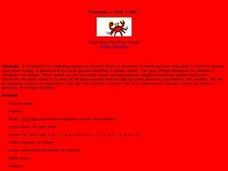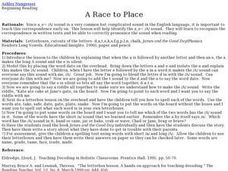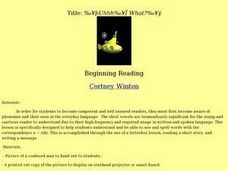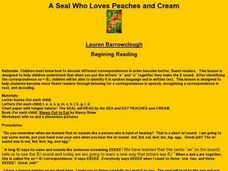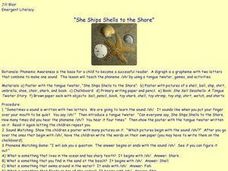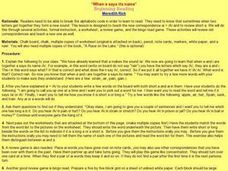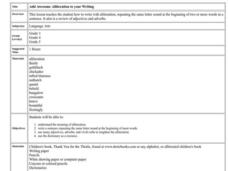Curated OER
Iggy and the Icky Sticky Inchworm
Learners read and spell words. They have to recognize that letters stand for phonemes and spellings map out spoken words. Long and short vowels are hard to recognize and this lesson focuses on that. The short i is taught in the...
Curated OER
"Aaaaaaa...a Fast Crab! "
Students participate in an emergent literacy lesson that focuses on the skill of phonemic awareness. The phoneme chosen is the letter "a". They need to correlate the sound to the letter.
Curated OER
A Race to Place
Students distinguish between short vowel a and long vowel a. They are introduced to the vowel-consonant-e pattern that changes short vowel sounds into long vowel sounds. They practice spelling words with the vowel-consonant-e pattern.
Curated OER
Uhhh..What?
Students identify and become competent and in reading the letter u, pronounced /uh/. They also use and spell words with the correspondance u = /uh/ by the use of a letterbox lesson, reading a short story, and writing a message.
Curated OER
Tick Tock /t/
Students review letter recognition for the letter /t/ and the sound of the letter /t/. They write an upper- and lower-case /t/ and recognize the sound of t as well as the letter when combined with other letters in the form of a word.
Curated OER
Aaaa! The Baby is Crying!
Pupils discover the correlation between graphemes and phonemes. They distinguish phonemes in verbal word contexts and match the letters to the phonemes. They focus on working to recognize the phoneme /a/ in its oral and written form.
Curated OER
Allie the Rat
Students identify the letter a and the short vowel sound it makes. They do a tongue twister with the sound in it and write what the letter a looks like on primary paper. Students have to listen to or read a story called Pat's Jam and...
Curated OER
The Door is Creaky E
Learners observe the prop of a door to demonstrate the sound of the phonemic sound of the letter "e". Then they drill and practice the sound with the teacher. The essential importance of the skill of phonemic awareness is stressed in the...
Curated OER
E-E-E-E-Extra E-E-E-E-Effort
Students listen to a tongue twister emphasizing the short e sound. They practice writing the letter e and attaching different words with that sound to it. They listen to a book about a dog that enhances the letter e. They write a...
Curated OER
A Seal Who Loves Peaches and Cream
Students decode correspondence in order to become better, fluent readers. When the letters e and a are put together they make the E sound. They become more fluent readers through listening for a correspondence in speech, in text, and...
Curated OER
O No!
First graders distinguish between short vowel a and long vowel O. They are introduced to the vowel-consonant-e pattern that changes short vowel sounds into long vowel sounds. They practice spelling words with the vowel-consonant-e pattern.
Curated OER
Ehhh! What'd ya say? Eeeggs
Students identify the vowel sound with a short e. They distinguish this sound /e/ in written and spoken words. Finally, students identify and spell using a letterbox lesson and reading various words with the vowel sound and are...
Curated OER
Chug-a-Chug-a Choo Choo
First graders identify the digraphs in written and spoken language. After a brief discussion on the combinations of letters that comprise digraphs, 1st graders practice identifying initial and final placement of the digraph /ch/ in words...
Curated OER
Open Your Mouth and Say Ahh!
Students identify and hear distinct sounds in spoken and written language. Then they develop a connection between phonemes and their letter symbols which is a key factor in the success of learning how to read and write. Students also...
Curated OER
EA Words
Students determine if the "e" sound is long or short in words. For this language arts lesson, students practice discriminating between the long and short "e" sounds by practicing with word cards that are embedded in the lesson. This...
Curated OER
She Ships Shells to the Shore
First graders identify the digraph /sh/ in written and spoken language. After a brief discussion the independent and combined sounds of the phonemes /s/ and /h/ students practice identifying initial and final placement of the new digraph...
Curated OER
Hurry Hurry!
First graders identify the fact that groups of phonemes form spoken and written words. They practice working with identifying words that have the letter "h" and point to its position in words.
Curated OER
Baby Sally is Upset Again!
Pupils, assessing how to read and write, join together grapheme's and the phonemes that make up words. They practice recognizing in oral and written form the vowel /a/. The book, "Matt and Rags," is introduced to the students in this...
Curated OER
AAAAAAAAAAA! Stop Crying!
Students practice recognizing the phoneme /a/ in spoken words. They interact with the book, "A Cat's Nap," and a poster with Abby and Allen on it that are asking animals for apples, and cards with words on them like at, mad, went, bag,...
Curated OER
Bless You
Students practice recognizing the phoneme /a/ in spoken and written words as well as by symbol. They interact with the book, "The Cat Nap," from Educational Insights and the Dr. Seuss book, "ABC's Book." Each student also plays a memory...
Curated OER
When A Says Its Name
Students are introduced to the concept of vowel digraphs. They identify the digraph /ai/ in spoken language. After a brief discussion, students apply the rule for reading and spelling words containing the /ai/ digraph by playing word bingo.
Curated OER
Add Awesome Alliteration to Your Writing
Students explore alliteration. In this writing lesson, students read the book Thank You for the Thistle and create sentences with alliteration. Students create an alphabet booklet with alliteration.
Curated OER
Using a Dictionary: Root Words
A dictionary is a very helpful tool. Teach your third graders how to locate words, define them, and understand what root words are. They look up 12 words, write their definitions, then determine the root word that helps categorize each...
Curated OER
Phonics: Words with More Than One Syllable (CV/C) Rule A
Knowing basic phonics rules can help learners increase their reading accuracy, pronunciation, and spelling. Third graders practice breaking or chunking words based on the cv/c syllable rule. They take note of where to break each word,...



